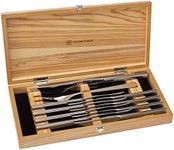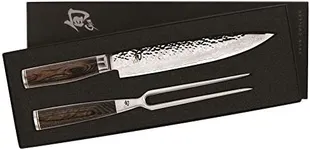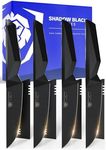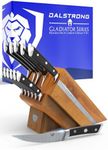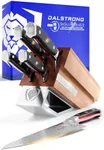Buying Guide for the Best Carving Knife Sets
Choosing the right carving knife set can make a significant difference in your kitchen experience, especially when it comes to preparing meats and other large cuts of food. A good carving knife set should offer precision, comfort, and durability. Here are some key specifications to consider when selecting the best carving knife set for your needs.Blade MaterialThe blade material is crucial because it affects the knife's sharpness, durability, and ease of maintenance. Common materials include stainless steel, high-carbon stainless steel, and ceramic. Stainless steel is resistant to rust and easy to maintain, making it a good all-around choice. High-carbon stainless steel is harder and holds an edge longer but may require more care to prevent rust. Ceramic blades are extremely sharp and lightweight but can be brittle and prone to chipping. Choose a material based on your willingness to maintain the knife and your need for sharpness and durability.
Blade LengthBlade length determines how well the knife can handle different sizes of meat and other foods. Carving knives typically range from 8 to 14 inches. Shorter blades (8-10 inches) offer more control and are easier to handle, making them suitable for smaller cuts of meat. Longer blades (12-14 inches) are better for larger cuts and provide smoother, more consistent slices. Consider the types of food you will be carving most often to determine the ideal blade length for you.
Handle MaterialThe handle material affects the comfort and grip of the knife. Common materials include wood, plastic, and composite. Wooden handles offer a traditional look and feel but may require more maintenance to prevent cracking. Plastic handles are durable and easy to clean but may not provide the same level of grip as other materials. Composite handles combine the best of both worlds, offering durability and a comfortable grip. Choose a handle material that feels comfortable in your hand and suits your maintenance preferences.
Balance and WeightThe balance and weight of a carving knife affect how it feels in your hand and how easy it is to control. A well-balanced knife will feel comfortable and stable, making it easier to carve precise slices. Heavier knives can provide more cutting power but may be tiring to use for extended periods. Lighter knives are easier to handle but may require more effort to cut through tougher meats. Consider your strength and comfort level when choosing the balance and weight of your carving knife.
Edge RetentionEdge retention refers to how long the knife stays sharp between sharpenings. Knives with good edge retention require less frequent sharpening, saving you time and effort. High-carbon stainless steel blades typically offer the best edge retention, while stainless steel and ceramic blades may need more frequent sharpening. If you prefer a low-maintenance knife, look for one with excellent edge retention.
Included AccessoriesSome carving knife sets come with additional accessories such as a carving fork, sharpening steel, or storage case. A carving fork can help stabilize the meat while carving, a sharpening steel can help maintain the knife's edge, and a storage case can protect the knives when not in use. Consider which accessories are important to you and whether they add value to the set.







